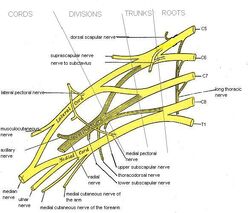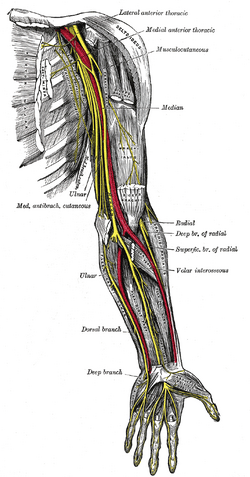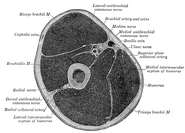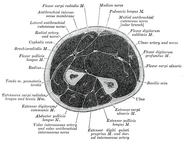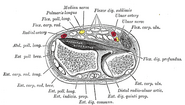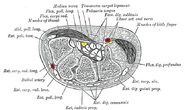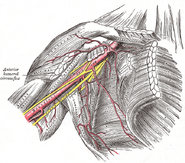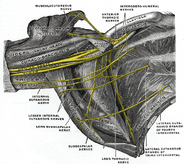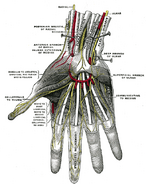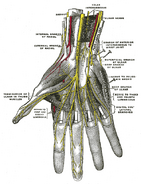Assessment |
Biopsychology |
Comparative |
Cognitive |
Developmental |
Language |
Individual differences |
Personality |
Philosophy |
Social |
Methods |
Statistics |
Clinical |
Educational |
Industrial |
Professional items |
World psychology |
Biological: Behavioural genetics · Evolutionary psychology · Neuroanatomy · Neurochemistry · Neuroendocrinology · Neuroscience · Psychoneuroimmunology · Physiological Psychology · Psychopharmacology (Index, Outline)
| Nerve: Ulnar nerve | ||
|---|---|---|
| Click image to enlarge - ulnar nerve is visible in lower left | ||
| Nerves of the left upper extremity. (Ulnar labeled at center left.) | ||
| Latin | nervus ulnaris | |
| Gray's | subject #210 943 | |
| Innervates | flexor carpi ulnaris flexor digitorum profundis lumbrical muscles opponens digiti minimi flexor digiti minimi abductor digiti minimi interossei adductor pollicis | |
| From | Medial cord | |
| To | ||
| MeSH | A08.800.800.720.050.850 | |
- Main article: Spinal nerves
In human anatomy, the ulnar nerve is a nerve which runs from the shoulder to the hand, at one part running near the ulna bone. It is the only exposed nerve in the human body (it is unprotected for a few centimeters at the elbow).
Course[]
The ulnar nerve comes from the medial cord of the brachial plexus, and runs inferior on the medial/posterior aspect of the humerus down the arm, going behind the medial epicondyle at the elbow. Because of the mild pain and tingling throughout the forearm associated with an inadvertent impact of the nerve at this point, it is usually called the funny bone. (It may also have to do with its location relative to the humerus, as the name "humerus" is homophonic to the word "humorous").
It enters the anterior (front) side of the forearm, and runs alongside the ulna. There it supplies one and a half muscles (flexor carpi ulnaris & medial half of flexor digiti profundus). It soon joins with the ulnar artery, and the two travel inferiorly together, deep to the flexor carpi ulnaris muscle.
After its journey down the ulna, the ulnar nerve enters the palm of the hand. Unlike the median nerve which travels below the flexor retinaculum of the hand and through the carpal tunnel, the ulnar nerve and artery pass superficial to the flexor retinaculum via the ulnar canal.
Branches and innervation[]
Muscular[]
The ulnar nerve and its branches innervate the following muscles in the forearm and hand:
- In the forearm, via the muscular branches of ulnar nerve:
- Flexor carpi ulnaris
- Flexor digitorum profundus (medial half)
- In the hand, via the deep branch of ulnar nerve:
- hypothenar muscles
- Opponens digiti minimi
- Abductor digiti minimi
- Flexor digiti minimi brevis
- Adductor pollicis
- The third and fourth lumbrical muscles
- Dorsal interossei
- Palmar interossei
- hypothenar muscles
- In the hand, via the superficial branch of ulnar nerve:
- Palmaris brevis
Cutaneous[]
The ulnar nerve also provides sensory innervation to the part of the hand corresponding to the fourth and fifth digits:
- Palmar branch of ulnar nerve - anterior
- Dorsal branch of ulnar nerve - posterior
Cubital Tunnel Syndrome[]
Cubital tunnel syndrome occurs when the Ulnar nerve is obstructed during its path along the outer edge of the elbow. This compression of the nerve often leads to a tingling or 'pins and needles' sensation in the little and ring fingers (as opposed to Carpal Tunnel Syndrome which affects the first, second and third fingers). Most cases will be minor and tend to come and go with time. Common causes are sleeping with the arm folded up, so the hand is at the persons neck. People frequently wake up with in these cases with tingling in the fingers, because the nerve has been pinched or squeezed. Treatment of these types of causes are easy to remedy and can involve simply altering sleeping positions to avoid aggravating the elbow area. In more extreme cases however where tingling is persistent, surgery is an option to move the nerve away from the area. [1]
See also[]
- Radial artery
- Axillary nerve
- Median nerve
Additional images[]
External links[]
- Dictionary at eMedicine Ulnar+nerve
- SUNY Figs 05:03-15 - "The major subdivisions and terminal nerves of the brachial plexus."
- SUNY Figs 07:04-04 - "Anterior view of the nerves, vessels, and superficial tendons that cross the left wrist."
- SUNY Figs 08:03-07 - "Transverse section through the carpal tunnel and distal row of the carpal bones."
- Duke Orthopedics ulnar_nerve
- Memorial University of Newfoundland - Anatomy at MUN nerve/ulnerv
- Hand kinesiology at University of Kansas nerves/ulnar.htm
- Atlas of anatomy at UMich hand_plexus - "Axilla, dissection, anterior view"
- Overview at neuro.wustl.edu
| Nerves of upper limbs (primarily): the brachial plexus |
|---|
| supraclavicular: dorsal scapular - suprascapular - to the subclavius - long thoracic
infraclavicular: lateral cord: musculocutaneous (lateral cutaneous of forearm) - lateral pectoral - lateral head of median (anterior interosseous, palmar, common palmar digital, proper palmar digital) medial cord: medial pectoral - medial cutaneous of forearm - medial cutaneous of arm - ulnar (muscular branches, dorsal branch, palmar branch, superficial branch, deep branch) - medial head of median posterior cord: subscapular (upper, lower) - thoracodorsal - axillary (superior lateral cutaneous of arm) - radial (muscular, inferior lateral cutaneous of arm, posterior cutaneous of arm, posterior cutaneous of forearm, superficial branch, deep branch, posterior interosseous) |
- de:Nervus ulnaris
- fr:Nerf ulnaire
- pt:nervo ulnar
- sv:Nervus ulnaris
| This page uses Creative Commons Licensed content from Wikipedia (view authors). |
